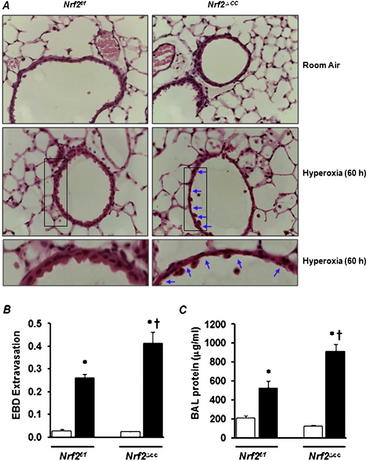Critical Care Medicine
Adult Critical Care
Conditional Deletion of Nrf2 in Airway Epithelium Exacerbates Acute Lung Injury and Impairs the Resolution of Inflammation
Reddy NM, Potteti HR, Mariani TJ, et al (Johns Hopkins Bloomberg School of Public Health, Baltimore, MD; Univ of Rochester Med Ctr, NY) Am J Respir Cell Mol Biol 45:1161-1168, 2011§
Evidence Ranking
• A
Expert Rating
• 3
Abstract
Oxidant stress, resulting from an excess of reactive electrophiles produced in the lung by both resident (epithelial and endothelial) and infiltrated leukocytes, is thought to play an obligatory role in tissue injury and abnormal repair. Previously, using a conventional (whole-body) knockout model, we showed that antioxidative gene induction regulated by the transcription factor Nrf2 is critical for mitigating oxidant-induced (hyperoxic) stress, as well as for preventing and resolving tissue injury and inflammation in vivo. However, the contribution to pathogenic acute lung injury (ALI) of the cellular stress produced by resident versus infiltrated leukocytes remains largely undefined in vivo. To address this critical gap in our knowledge, we generated mice with a conditional deletion of Nrf2 specifically in Clara cells, subjected these mice to hyperoxic insult, and allowed them to recover. We report that a deficiency of Nrf2 in airway epithelia alone is sufficient to contribute to the development and progression of ALI. When exposed to hyperoxia, mice lacking Nrf2 in Clara cells showed exacerbated lung injury, accompanied by greater levels of cell death and epithelial sloughing than in their wildtype littermates. In addition, we found that an Nrf2 deficiency in Clara cells is associated with a persistent inflammatory response and epithelial sloughing in the lungs during recovery from sublethal hyperoxic insult. Our results demonstrate (for the first time, to the best of our knowledge) that Nrf2 signaling in Clara cells is critical for conferring protection from hyperoxic lung injury and for resolving inflammation during the repair process (Figs 2 and 3).

Full access? Get Clinical Tree




